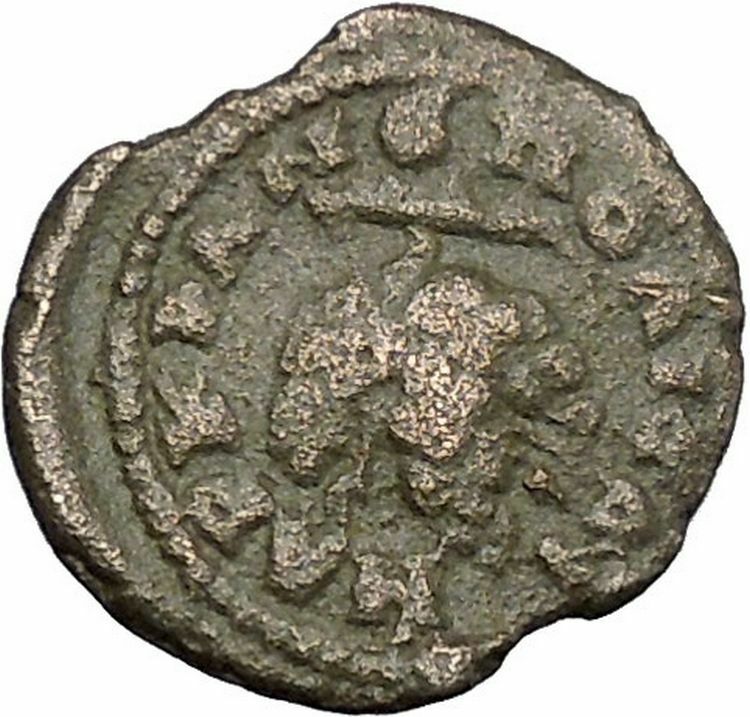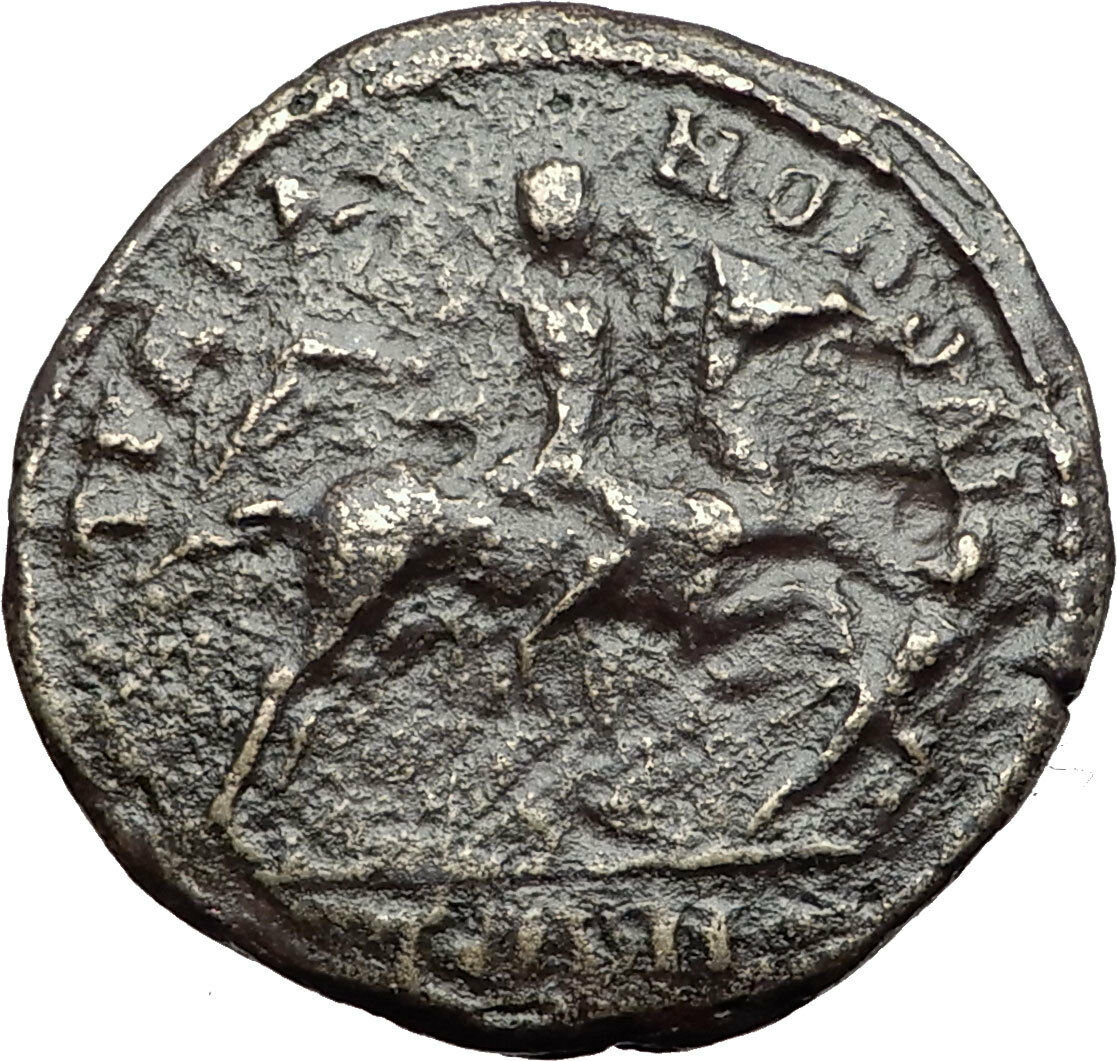|
Diadumenian
– Roman Caesar: 218 A.D. –
Bronze 17mm (2.89 grams) of
Marcianopolis in Moesia Inferior
Bare-headed, draped and cuirassed bust right.
MAPKIANOΠOΛEITΩN,
Asclepius standing facing, head left, leaning on
serpent-entwined
(medical symbol) staff.
Marcianopolis, or Marcianople was an ancient Roman city in
Thracia
. It was located at the site of modern
day Devnya
,
Bulgaria
.
The city was so renamed by Emperor
Trajan
after his sister
Ulpia Marciana
, and was previously known as
Parthenopolis. Romans repulsed a
Gothic
attack to this town in
267
(or 268
), during the reign of
Gallienus
.
Diocletian
made it the capital of the
Moesia Secunda
province.
Valens
made it his winter quarters in 368 and
succeeding years, Emperor
Justinian I
restored and fortified it. In 587,
it was sacked by the king of the
Avars
but at once retaken by the Romans. The
Roman army quartered there in 596 before crossing the Danube to assault the
Avars.
Between 893 and 972 it was one of the most important medieval cities in
south-eastern Europe.
You are bidding on the exact item pictured,
provided with a Certificate of Authenticity and Lifetime Guarantee of
Authenticity.
![Asclepius with his serpent-entwined staff[1]](https://upload.wikimedia.org/wikipedia/commons/thumb/9/97/Statue_of_Asklepios_NAMA_263_%28DerHexer%29.JPG/200px-Statue_of_Asklepios_NAMA_263_%28DerHexer%29.JPG)
 Asclepius Asclepius
is the god of medicine
and healing in ancient
Greek religion
. Asclepius represents the
healing aspect of the medical arts; his daughters are
Hygieia
(“Health”),
Iaso (“Medicine”),
Aceso
(“Healing”),
Aglæa/Ægle
(“Healthy Glow”), and
Panacea
(“Universal Remedy”). The
rod of Asclepius
, a snake-entwined staff,
remains a symbol of medicine today, although sometimes the
caduceus
, or staff with two snakes, is
mistakenly used instead. He was associated with the Roman/Etruscan god
Vediovis
. He was one of
Apollo
‘s servants.

The
rod of Asclepius, also known as the asklepian, is an ancient
symbol associated with
astrology
, the
Greek
god
Asclepius
and with
medicine
and
healing
. It consists of a
serpent
entwined around a
staff
. The name of the symbol derives from its
early and widespread association with
Asclepius
, the son of
Apollo
, who was a practitioner of medicine in
ancient
Greek mythology
. His attributes, the snake and
the staff, sometimes depicted separately in antiquity, are combined in this
symbol. The Rod of Asclepius also represents the constellation
Ophiuchus
(or Ophiuchus Serpentarius), the
thirteenth sign of the
sidereal zodiac
.
Hippocrates
himself was a worshipper of
Asclepius.
Serpents and snakes play a role in many of the world’s myths and legends.
Sometimes these mythic beasts appear as ordinary snakes. At other times, they
take on magical or monstrous forms. Serpents and snakes have long been
associated with good as well as with evil, representing both life and death,
creation and destruction.
Serpents and Snakes as Symbols. In religion, mythology, and
literature, serpents and snakes often stand for fertility or a creative life
force—partly because the creatures can be seen as symbols of the male sex organ.
They have also been associated with water and earth because many kinds of snakes
live in the water or in holes in the ground. The ancient Chinese connected
serpents with life-giving rain. Traditional beliefs in Australia, India, North
America, and Africa have linked snakes with rainbows, which in turn are often
related to rain and fertility.
As snakes grow, many of them shed their skin at various times, revealing a
shiny new skin underneath. For this reason snakes have become symbols of
rebirth, transformation, immortality, and healing. The ancient Greeks
considered snakes sacred to Asclepius, the god of medicine. He carried a
caduceus, a staff with one or two serpents wrapped around it, which has become
the symbol of modern physicians.
For both the Greeks and the Egyptians, the snake represented eternity.
Ouroboros, the Greek symbol of eternity, consisted of a snake curled into a
circle or hoop, biting its own tail. The Ouroboros grew out of the belief that
serpents eat themselves and are reborn from themselves in an endless cycle of
destruction and creation.
Serpents figured prominently in archaic Greek myths. According to some
sources,
Ophion (“serpent”, a.k.a. Ophioneus), ruled the world with Eurynome
before the two of them were cast down by Cronus and Rhea. The oracles of the
Ancient Greeks were said to have been the continuation of the tradition begun
with the worship of the Egyptian cobra goddess,
Wadjet.
The
Minoan
Snake
Goddess brandished a serpent in either hand, perhaps evoking her role
as source of wisdom, rather than her role as Mistress of the Animals (Potnia
theron), with a leopard
under each arm. She is a Minoan version
of the Canaanite
fertility goddess
Asherah.
It is not by accident that later the infant
Heracles,
a liminal hero on the threshold between the old ways and the new Olympian world,
also brandished the two serpents that “threatened” him in his cradle. Classical
Greeks did not perceive that the threat was merely the threat of wisdom. But the
gesture is the same as that of the Cretan goddess.
Typhon
the enemy of the Olympian gods is described as a vast grisly monster with a
hundred heads and a hundred serpents issuing from his thighs, who was conquered
and cast into Tartarus
by
Zeus,
or confined beneath volcanic regions, where he is the cause of eruptions. Typhon
is thus the chthonic figuration of volcanic forces. Amongst his children by
Echidna are Cerberus
(a monstrous three-headed dog with a
snake for a tail and a serpentine mane), the serpent tailed
Chimaera
, the serpent-like chthonic water beast
Lernaean Hydra and the hundred-headed serpentine dragon
Ladon.
Both the Lernaean Hydra and Ladon were slain by
Heracles.
Python
was the earth-dragon of
Delphi,
she always was represented in the vase-paintings and by sculptors as a serpent.
Pytho was the chthonic enemy of Apollo
, who slew her and remade her former home
his own oracle, the most famous in Classical Greece.
Amphisbaena a Greek word, from amphis, meaning “both ways”, and
bainein, meaning “to go”, also called the “Mother of Ants”, is a mythological,
ant-eating serpent with a head at each end. According to Greek mythology, the
mythological amphisbaena was spawned from the blood that dripped from
Medusa
the Gorgon‘s
head as
Perseus flew over the Libyan Desert with her head in his hand.
Medusa and the other Gorgons were vicious female monsters with sharp fangs
and hair of living, venomous snakes whose origins predate the written myths of
Greece and who were the protectors of the most ancient ritual secrets. The
Gorgons wore a belt of two intertwined serpents in the same configuration of the
caduceus.
The Gorgon was placed at the highest point and central of the relief on the
Parthenon.
Asclepius, the son of Apollo and Koronis, learned the secrets of
keeping death at bay after observing one serpent bringing another (which
Asclepius himself had fatally wounded) healing herbs. To prevent the entire
human race from becoming immortal under Asclepius’s care, Zeus killed him with a
bolt of lightning. Asclepius’ death at the hands of Zeus illustrates man’s
inability to challenge the natural order that separates mortal men from the
gods. In honor of Asclepius, snakes were often used in healing rituals.
Non-poisonous snakes were left to crawl on the floor in dormitories where the
sick and injured slept. In
The Library
,
Apollodorus claimed that
Athena
gave Asclepius a vial of blood from the Gorgons. Gorgon blood had magical
properties: if taken from the left side of the Gorgon, it was a fatal poison;
from the right side, the blood was capable of bringing the dead back to life.
However
Euripides wrote in his tragedy
Ion
that the Athenian queen Creusa had
inherited this vial from her ancestor Erichthonios, who was a snake himself and
receiving the vial from Athena. In this version the blood of Medusa had the
healing power while the lethal poison originated from Medusa’s serpents.
Laocoön
was allegedly a priest of Poseidon
(or of Apollo, by some accounts) at
Troy;
he was famous for warning the Trojans in vain against accepting the Trojan Horse
from the Greeks, and for his subsequent divine execution. Poseidon (some say
Athena),
who was supporting the Greeks, subsequently sent sea-serpents to strangle
Laocoön and his two sons, Antiphantes and Thymbraeus. Another tradition states
that Apollo sent the serpents for an unrelated offense, and only unlucky timing
caused the Trojans to misinterpret them as punishment for striking the Horse.
Olympias, the mother of
Alexander the Great
and a princess of the
primitive land of
Epirus
, had the reputation of a snake-handler,
and it was in serpent form that Zeus was said to have fathered Alexander upon
her; tame snakes were still to be found at Macedonian
Pella
in the 2nd century AD (Lucian,
Alexander the false prophet
) and at
Ostia
a bas-relief shows paired coiled serpents
flanking a dressed altar, symbols or embodiments of the
Lares
of the household, worthy of veneration (Veyne 1987 illus p 211).
Aeetes
, the king of
Colchis
and father of the sorceress Medea
, possessed the
Golden Fleece. He guarded it with a massive serpent that never slept.
Medea, who had fallen in love with Jason
of the
Argonauts,
enchanted it to sleep so Jason could seize the Fleece.
Marcus Opellius Antoninus Diadumenianus or Diadumenian
(208–218) was the son of the
Roman
Emperor
Macrinus
, and served his father briefly as
Caesar
(May 217–218) and as
Augustus
(in 218). Diadumenian was born in 14th of September 208 a.C
or according to
Historia Augusta
in 19th of
September
208 a.C because he
shared the same birthday with the emperor
Antoninus Pius
. His mother was Empress
Nonia
Celsa
, although her existence remains dubious, because she was only
mentioned by the
Historia Augusta
. He was born Marcus Opellius Diadumenianus, but his
name was changed and added Antoninus to solidify connection to the family
of
Marcus Aurelius
as done by
Caracalla
.
Diadumenian had little time to enjoy his position or to learn anything from
its opportunities because the legions of
Syria
revolted and declared
Elagabalus
ruler of the
Roman
Empire
. When
Macrinus
was defeated on June 8, 218, at
Antioch
,
Diadumenian followed his father’s death.
|





![Asclepius with his serpent-entwined staff[1]](https://upload.wikimedia.org/wikipedia/commons/thumb/9/97/Statue_of_Asklepios_NAMA_263_%28DerHexer%29.JPG/200px-Statue_of_Asklepios_NAMA_263_%28DerHexer%29.JPG)
 Asclepius
Asclepius



